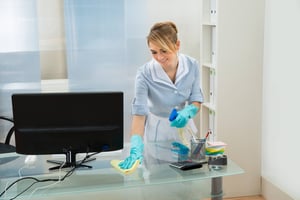Executive Summary
- While we don't know the long-term mix of in-office versus remote work, organizations need to plan how to safely re-open their office despite the ongoing presence of COVID-19.
- There are multiple factors to consider, ranging from local regulations to safety requirements to the specific needs of your employees and visitors.
- Regardless of what protocols you put in place, be prepared to modify them as new information and best practices emerge.
As much as we’ve all enjoyed some extra time in our PJs and sweatpants during the COVID-19 pandemic, a return to the workplace is inevitable for many organizations, especially with vaccinations on the way.
If you’re thinking about sending some or all of your employees back to the office or reopening your business to customers for the first time, here’s a high-level checklist of what to consider, along with resources to inform your decisions.
Check Your State’s Capacity Restrictions
Several states still are operating under workplace capacity restrictions that will require a staggered schedule for your employees and a notification protocol for anyone who plans to drop by. Start by looking on your state’s department of health website to check on current limitations.
Prep Your Space
In order to ensure employee safety and peace of mind, you may need to think through your office or workplace configurations. Do you need to remove some workstations to create additional buffer space between employees? Do you want to close common areas like lounges or lunchrooms—or create more so that they are each less trafficked? Do you need to purchase any plexiglass shields for customer-facing staff? At a minimum, here are some basics that will need to be addressed:
- Ensure proper ventilation.
- Place hand sanitizer dispensers at key locations and provide disinfectant wipes.
- Install informational signage (there’s a printable library of posters here) on proper hygiene, such as hand washing, directional traffic, and any new office practices.
- Encourage digital file sharing, rather than paper formats, for any intraoffice processes.
- If you’re following a mask-wearing protocol at work, you may want to keep some extra masks on hand.
- Assign a COVID coordinator to help facilitate planning and communication, reorder cleaning supplies, and handle day-to-day safety questions.
Plan Your Cleaning Procedures
 Think through how you will sanitize and clean your workspaces, set an expected cleaning schedule, and assign (or hire) team members to handle the duties. You’ll want to include the following in your plan:
Think through how you will sanitize and clean your workspaces, set an expected cleaning schedule, and assign (or hire) team members to handle the duties. You’ll want to include the following in your plan:
- Maintain more frequent than usual housekeeping practices, including disinfecting of surfaces, handles, equipment, and other elements of the work environment.
- When choosing cleaning products, the Environmental Protection Agency (EPA) has an updated list of disinfectants proven to kill SARS-CoV-2, the virus that causes COVID-19.
- Promote frequent and thorough hand washing, making sure sinks are available, or providing alcohol-based hand sanitizers containing at least 60% alcohol.
- Provide employees and customers with tissues and trash bins.
- Discourage employees from sharing others’ desks, computers, phones, offices, or other equipment.
Review the OSHA report on Preparing Workplaces for COVID-19 for more details.
Expect Absences
It’s important to maintain flexible, accommodating policies that permit employees to stay home if they suspect any hint of illness or to care for a sick family member. This will ensure workers feel comfortable reporting possible exposure or sickness and prevent them from bringing it to the workplace. Make a backup plan for key employees if they are needed in-person, and expect to use it more than usual.
The U.S. Department of Labor outlines what paid employee leave you may be required to provide under the Families First Coronavirus Response Act (FFCRA or Act).
Provide Clear Illness Guidelines
After an employee is sick, can they return to work after a negative COVID-19 test, or must they quarantine for the full 10 days? Does a runny nose mean they should automatically stay home? You’ll need to be prepared to answer these questions and more, with a handy set of guidelines distributed to employees.
The CDC offers answers to many illness-related FAQs here.
Bring Staff Into the Fold
Employees will feel empowered when you create an office task force to help ensure reintroduction to the workplace is going smoothly. This should also include reporting back on the employee's “pulse” of how things are going and whether they need more information or additional support. Communicate frequently, as the main complaint heard by employees returning to work is a lack of transparency about the possible presence of illness or exposure.
Communicate Frequently with Employees
Employees will want to know your plans to help keep them safe, and what expectations you have for them as you return to work. Returning to work is a chance to celebrate your team, their hard work in difficult conditions over the last many months, and the opportunity to work together once again. Remember that many of your team members may have gotten comfortable working from home, so be sure to express your gratitude for their presence in the office verbally and maybe even with gestures such as “welcome back” gifts.
Photo credit: Synergycps